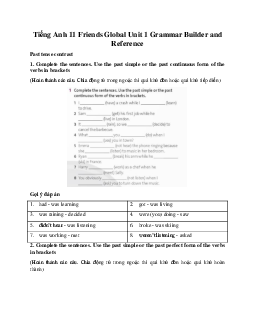



Preview text:
Giải Tiếng Anh 11 Unit 1: 1I Culture Bài 1
SPEAKING Describe the photos. Can you name the ethnic groups in the photos?
(Mô tả các bức ảnh. Bạn có thể kể tên các nhóm dân tộc trong ảnh?) Gợi ý đáp án
In the first and the second pictures, I can see two different ethnic groups of Vietnam
because they are wearing different costumes. I guess they are performing at the
famous festivals of their cultures because I can see they are dancing with some special
musical instruments. On the other hand, in the third picture, I can see three children,
they can be from 10 to 16 years old. Looking at the background and their clothes, I'm
sure that they are also an ethnic group living in a mountainous area.
Actually, I can't name what ethnic groups they are in the three pictures. Bài 2
Read the text. Where in Viet Nam do these people live?
(Đọc văn bản. Những người này sống ở đâu tại Việt Nam?) 1. Tay 2. Muong 3. Khmer 4. Thai
VIET NAM – Culture and customs
Viet Nam is a multi-racial country with 54 ethnic groups. More than 85% of Viet
Nam's population is the Kinh people who mainly inhabit the Red River delta, the
central coastal delta, the Mekong delta and major cities. The rest of Viet Nam's
population, about 8 million, is scattered in mountainous areas around the country and
makes up the other 53 ethnic groups. Major ethnic groups include Tay and Nung (in
North East provinces), Thai and Muong people (in Phu Tho Province, Hoa Binh
Province), Hoa (around Viet Nam), Khmer (in the Mekong Delta). All ethnic groups
in Viet Nam have achieved high levels of development in terms of culture and social strata.
Ethnic groups have distinct cultures and customs. Take marriage practices and
weddings as an example. On arrival at the groom's house, a bride in the Nung people
pours a bottle of water into a saucepan, which symbolises hard work and dedication to
the family. Meanwhile, a wedding ceremony of the Tay people is characterised by a
lot of singing known as "hat quan lang". A Thai man usually stays with and works for
his fiancé's family for 3 years before the wedding ceremony. Varied as the customs
are, they all mean blessings to the newly-weds in their marriage life. Gợi ý đáp án
1. Tay - in North East provinces
2. Muong - in Phu Tho Province, Hoa Binh Province
3. Khmer - in the Mekong Delta
4. Thai - in Phu Tho Province, Hoa Binh Province Bài 3
Read the text again. Are these statements true or false? Write (T) and (F).
(Đọc lại văn bản. Những câu này đúng hay sai? Viết (T) và (F).)
1. Most of Vietnamese people belong to the Kinh ethnic group.
2. Different wedding customs of ethnic groups have different meanings.
3. As far as culture is concerned, the Kinh people is the most developed in Viet Nam. Gợi ý đáp án 1. True 2. False 3. False Bài 4
Listen to three Westerners talking about the wedding ceremonies they witnessed
in Viet Nam. Which ethnic groups are mentioned by the speakers?
(Hãy nghe ba người phương Tây nói về những nghi thức đám cưới mà họ đã chứng
kiến ở Việt Nam. Người nói đề cập đến những dân tộc nào?) Bài 5
Listen again. Match the sentences with the speakers (1-3). Some sentences match
with more than one speaker.
(Lắng nghe một lần nữa. Nối các câu với người nói (1-3). Một số câu phù hợp với
nhiều hơn một người nói.) Which speaker(s)
A. were amazed by the ceremony?
B. had read about the customs before?
C. mention his/her previous trip to Việt Nam?
D. make a positive comment about the bride?
E. understand the meaning of the customs? Bài 6
SPEAKING Work in pairs. Discuss these questions.
(Làm việc theo cặp. Thảo luận những câu hỏi sau.)
1. Which ethnic groups are you in contact with most often? What is most special about them?
2. How are weddings held in your family? What customs do you find the most meaningful? Gợi ý đáp án 1.
A: Which ethnic groups are you in contact with most often?
B: The ethnic group I am in contact with most often is Kinh because I was born in
city and most of them live here, too.
A: Can you tell me what is most special about them?
B: The Kinh uses the official language of Vietnam, Vietnamese, as the main
language. In Vietnamese society, the Kinh have played a vital part in Vietnamese
culture and tradition as well as developing the economy. 2.
A: How are weddings held in your family?
B: The groom’s family and the bride’s family will meet each other to choose the best
day for them to celebrate their wedding party. On the wedding day, the groom’s
family and relatives go to the bride’s house bringing a lot of gifts wrapped in red
papers. Ladies and women are all dressed in Ao Dai. Men could be in their suits or
men traditional Ao Dai. The couple should pray before the altar ask their ancestors for
permission for their marriage, then express their gratitude to both groom and bride’s
parents for raising and protecting them.
A: What customs do you find the most meaningful?
B: I like the moment when they bow their heads to each other to show their gratitude
and respect toward their soon-to-be husband or wife. I also like the moment when
their parents take turns to share their experience and give blessings. For me, it’s extremely meaningful.




